The Healthist
Theory of Change
Picture this: a middle-aged woman lays on a gurney in an urban hospital emergency room. She arrived in an ambulance she didn't call. She doesn't answer questions clearly. The nurses and doctors have examined all her systems. She doesn't have any major cuts or wounds. Her lab work shows things she should discuss with her primary doctor but is otherwise fine. Her heart and lungs sound ok. While she has some minor needs, doctors haven't found anything significantly concerning.
Now, imagine the camera zooming out. We see much more of her life. We see that she and her two young kids have been staying on the couch of a friend for almost a year. She works three part-time jobs. She was on food support but when she lost her housing, she found it too hard to keep up with the paperwork required for benefits. Her biggest concern is what her kids will eat every night and how long she'll be able to support them.
With this broader view it is clear she needs help. And while it may not be her cardiovascular or immune system which is compromised, the other systems in her life are failing. Losing her housing is the failure of a major organ in her life. Losing food support and transportation are like major systems in the body shutting down.
When we zoom out, we see a more complete picture of a person and their life, we see how every part of our lives is part of our health. We see that health not only refers to physical and mental wellbeing, but extends to economic, educational, and social health.
How might we build systems to diagnose and treat the nonclinical parts of our health?
Zooming out and seeing the other major organs and systems in our lives —our housing, our educational and economic opportunities, privilege and inequality, food, transportation, and mental wellbeing —shows us how much more of a person's needs we have to care for in order for them to truly feel and be healthy.
This is a sea change in how we think about health and wellbeing.
The COVID-19 pandemic is causing everyone in our society to see the zoomed out, broader view. While no one is feeling the impacts more than vulnerable communities and families, most of us are now clearly seeing how going to school or having a job is part of our overall health. We are seeing how access to resources are unevenly distributed.
We are seeing how there's never been a more urgent time to reimagine what we mean when we talk about health.
This is a complex puzzle and the good news is that we have many of the puzzle pieces. Our community hospitals know how to care for us medically. Our local and state support services have models for supporting vulnerable communities. We have amazing community organizations who support their neighbors through creative outreach programs. We're seeing schools and employers do real-time problem solving.
But, we must put the puzzle pieces together with the communities those pieces serve. We have to identify where there are missing pieces, and together through human-centered design and rapid sprints, fill those gaps with services that are usable, accessible, and impactful.
Change at every level
Creating a healthist world, one where every part of our lives is valued as part of our health, is not an overnight change. Much like the environmentalist movement, it requires everything from individual action to societal commitment.
Government agencies have tremendous arms reach to convene communities and the institutions that support them. And have the ability to create and facilities new systems of care which address the social organs that make up our health.
Employers, brands, and companies can adopt a healthist mindset and put the prioritization of health on part when growth as a goal. By considering the health impacts of what they make, how they work, and the communities they serve, they are part of making a more healthist world.
Community organizations understand the people in their service areas. They know their needs. They are powerful healthist partners in being able to shine a light on the untreated social systems.
And, today, we understand how even the simple act of wearing a mask is a healthist action. It is an example of how each of us are doing small things in our own lives to help care for the broader health of everyone.
Now’s the time
The Healthist Initiative believes we have to adopt this zoomed out view of health - one where we see a broader view of our bodies that includes how and where we live.
When we ask people how they define health and wellbeing most of us describe being able to live their best days. Our ability to live our best days is impacted whether we suffer a clinical diagnosis or job loss. That loss of health affects other parts of our broader health body. It might impact our ability to learn or work, it might change how and if we can put food on the table. When one of our organs, be it our housing or our hearing, suffers, it impacts every other part of our body.
Building a new model of care which is capable of addressing this broader view is within reach. It requires coalitions of willing partners. It requires a design-based approach to understanding needs and identifying gaps. And it requires every part of our society sharing a commitment to being healthists.



